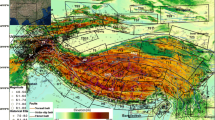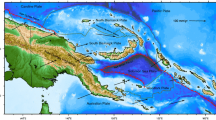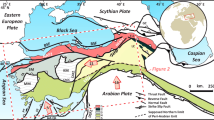Abstract
This article presents a seismic hazard assessment for northern Iran, where a smoothed seismicity approach has been used in combination with an updated seismic catalog and a ground motion prediction equation recently found to yield good fit with data. We evaluate the hazard over a geographical area including the seismic zones of Azerbaijan, the Alborz Mountain Range, and Kopeh-Dagh, as well as parts of other neighboring seismic zones that fall within our region of interest. In the chosen approach, seismic events are not assigned to specific faults but assumed to be potential seismogenic sources distributed within regular grid cells. After performing the corresponding magnitude conversions, we decluster both historical and instrumental seismicity catalogs to obtain earthquake rates based on the number of events within each cell, and smooth the results to account for the uncertainty in the spatial distribution of future earthquakes. Seismicity parameters are computed for each seismic zone separately, and for the entire region of interest as a single uniform seismotectonic region. In the analysis, we consider uncertainties in the ground motion prediction equation, the seismicity parameters, and combine the resulting models using a logic tree. The results are presented in terms of expected peak ground acceleration (PGA) maps and hazard curves at selected locations, considering exceedance probabilities of 2 and 10% in 50 years for rock site conditions. According to our results, the highest levels of hazard are observed west of the North Tabriz and east of the North Alborz faults, where expected PGA values are between about 0.5 and 1 g for 10 and 2% probability of exceedance in 50 years, respectively. We analyze our results in light of similar estimates available in the literature and offer our perspective on the differences observed. We find our results to be helpful in understanding seismic hazard for northern Iran, but recognize that additional efforts are necessary to obtain more robust estimates at specific areas of interest and different site conditions.














Similar content being viewed by others
References
Abdi F, Mirzaei N, Shabani E (2013) Ground-motion scenarios consistent with PSH deaggregation for Tehran, capital city of Iran. Nat Hazards Earth Syst Sci 13(3):679–688. doi:10.5194/nhess-13-679-2013
Abdollahzadeh G, Sazjini M, Shahaky M, Tajrishi FZ, Khanmohammadi L (2014) Considering potential seismic sources in earthquake hazard assessment for northern Iran. J Seismol 18(3):357–369. doi:10.1007/s10950-013-9412-1
Abrahamson NA, Silva W (2008) Summary of the Abrahamson & Silva NGA ground-motion relations 24(1):67–97. doi:10.1193/1.2924360
Akinci A, Mueller C, Malagnini L, Lombardi A (2004) Seismic hazard estimate in the Alps and Apennines (Italy) using smoothed historical seismicity and regionalized predictive ground-motion relationships. Boll Geofis Teor Appl 45(4):285–304
Akkar S, Bommer JJ (2010) Empirical equations for the prediction of PGA, PGV, and spectral accelerations in Europe, the Mediterranean region, and the Middle East. Seismol Res Lett 81(2):195–206
Ambraseys NN (2009) Earthquakes in the Mediterranean and Middle East, a multidisciplinary study of seismicity up to 1900 Cambridge University Press, Cambridge, United Kingdom
Ambraseys NN, Melville CP (1982) A history of Persian earthquakes. Cambridge University Press, Cambridge, United Kingdom
Ambraseys NN, Melville CP, Adams RD (2005) The seismicity of Egypt, Arabia and the Red Sea: A historical review. Cambridge University Press, Cambridge, United Kingdom
Atkinson GM, Bommer JJ, Abrahamson NA (2014) Alternative approaches to modeling epistemic uncertainty in ground motions in probabilistic seismic-hazard analysis . Seismol Res Lett 85(6):1141–1144. doi:10.1785/0220140120
Barani S, Spallarossa D, Bazzurro P, Eva C (2007) Sensitivity analysis of seismic hazard for western Liguria (north western Italy): A first attempt towards the understanding and quantification of hazard uncertainty. Tectonophysics 435(1–4):13–35. doi:10.1016/j.tecto.2007.02.008
Berberian M (1981) Active faulting and tectonics of Iran. In: Gupta HK, Delany FM (eds) Zagros Hindu Kush Himalaya Geodynamic Evolution, American Geophysical Union, Washington, D. C., 10.1029/GD003p0033
Berberian M (1995) Natural hazards and the first earthquake catalog of Iran: Volume 1: Historical hazards in Iran prior to 1900. A UNESCO/IIEES publication during UN/IDNDR, International Institute of Earthquake Engineering and Seismology, 603 (in English) + 66 (in Persian) pp.
Berberian M, Arshadi S (1976) On the evidence of the youngest activity of the North Tabriz Fault and the seismicity of Tabriz city. In: Berberian M (ed) Contributions to the Seismotectonics of Iran (Part II), Ministry of Industry and Mines, Geological Survey of Iran, Report, pp 397–418
Berberian M, Yeats RS (1999) Patterns of historical earthquake rupture in the Iranian plateau. Bull Seismol Soc Am 89(1):120–139
Berberian M, Yeats RS (2001) Contribution of archaeological data to studies of earthquake history in the Iranian plateau. J Struct Geol 23(2):563–584. doi:10.1016/S0191-8141(00)00115-2
BHRC (2014) Iranian code of practice for seismic resistant design of buildings (Standard No. 2800) Ministry of Housing and Urban Development, and Building & Housing Research Center 4th revision, Tehran, Iran
Boore DM, Atkinson GM (2008) Ground-motion prediction equations for the average horizontal component of PGA, PGV, and 5%-damped PSA at spectral periods between 0.01 s and 10.0 s. Earthq Spectra 24(1):99–138. doi:10.1193/1.2830434
Boostan E, Tahernia N, Shafiee A (2015) Fuzzy—probabilistic seismic hazard assessment, case study: Tehran region, Iran. Nat Hazards 77(2):525–541. doi:10.1007/s11069-014-1537-1
Boyd OS, Mueller CS, Rukstales K (2007) Preliminary earthquake hazard map of Afghanistan. Tech. Rep. OFR 2007-1137, U.S. Geological Survey
Boyd OS, Zeng Y, Bufe CG, Wesson RL, Pollitz F, Hardebeck JL (2008) Toward a time-dependent probabilistic seismic hazard analysis for Alaska. In: Freymueller JT, Haeussler PJ, Wesson RL, Ekström G (eds) Active Tectonics and Seismic Potential of Alaska, American Geophysical Union, Washington, D. C. doi:10.1029/179GM23, pp 399–416
Cao T, Petersen MD, Reichle MS (1996) Seismic hazard estimate from background seismicity in southern California. Bull Seismol Soc Am 86(5):1372–1381
Castellaro S, Mulargia F, Kagan YY (2006) Regression problems for magnitudes. Geophys J Int 165(3):913–930. doi:10.1111/j.1365-246X.2006.02955.x
Chiou BJ, Youngs RR (2008) An NGA model for the average horizontal component of peak ground motion and response spectra. Earthq Spectra 24(1):173–215. doi:10.1193/1.2894832
Deniz A, Yucemen MS (2010) Magnitude conversion problem for the Turkish earthquake data. Nat Hazards 55(2):333–352. doi:10.1007/s11069-010-9531-8
Escordilis EM (2006) Empirical global relations converting M S and m b to moment magnitude. J Seismol 10(2):225–236. doi:10.1007/s10950-006-9012-4
Foteva G, Ilieva M, Botev E (2006) Spatially-smoothed seismicity modelling of seismic hazard in the Sofia area. Annuaire de l’Université de Sofia, “St Kliment Ohridski, Faculté de Physique 99
Frankel A (1995) Mapping seismic hazard in the central and eastern United States. Seismol Res Lett 66(4):8–21. doi:10.1785/gssrl.66.4.8
Gardner J, Knopoff L (1974) Is the sequence of earthquakes in southern California, with aftershocks removed, Poissonian? Bull Seismol Soc Am 64(5):1363–1367
Ghafory-Ashtiany M (1999) Rescue operation and reconstruction of recent earthquakes in Iran. Disaster Prevention and Management: An International Journal 8(1):5–20. doi:10.1108/09653569910258174
Ghasemi H, Zare M, Fukushima Y, Koketsu K (2009) An empirical spectral ground-motion model for Iran. J Seismol 13(4):499–515. doi:10.1007/s10950-008-9143-x
Ghodrati Amiri G, Amrei SR (2008) Seismic hazard assessment of Gilan province including Manjil in Iran. In: Proceedings of the 14th World Conference on Earthquake Engineering, October 12-17, Beijing, China
Ghodrati Amiri G, Motamed R, Es-Haghi HR (2003) Seismic hazard assessment of metropolitan Tehran, Iran. Abstr J Earthq Eng 7(3):347–372. doi:10.1142/S136324690300119X
Ghodrati Amiri G, Khoshnevis N, Razavian Amrei S (2013) Probabilistic assessment of earthquake damage and loss for the city of Tehran, Iran. Journal of Rehabilitation in Civil Engineering 1(2):10–23
Golara A (2014) Probabilistic seismic hazard analysis of interconnected infrastructure: A case of Iranian high-pressure gas supply system. Nat Hazards 73(2):567–577. doi:10.1007/s11069-014-1087-6
Gutenberg B, Richter CF (1944) Frequency of earthquakes in California. Bull Seismol Soc Am 34(4):185–188
Herrmann R (1977) Recurrence relations. Earthquake Notes 88:47–49
Jones-Brydges H (1834) An account of the transactions of His Majesty’s Mission to the Court of Persia, in the years 1807–11, to which is added a brief history of the Wahauby, vol 1. James Bohn, London, United Kingdom
Kafka AL, Levin SZ (2000) Does the spatial distribution of smaller earthquakes delineate areas where larger earthquakes are likely to occur? . Bull Seismol Soc Am 90(3):724–738. doi:10.1785/0119990017
Kagan YY, Jackson DD (1994) Long-term probabilistic forecasting of earthquakes. J Geophys Res 99(B7):13,685–13,700. doi:10.1029/94jb00500
Kalkan E, Gulkan P (2004) Site-dependent spectra derived from ground motion records in Turkey. Earthq Spectra 20(4):1111–1138. doi:10.1193/1.1812555
Kalkan E, Gülkan P, Yilmaz N, Çelebi M (2009) Reassessment of probabilistic seismic hazard in the Marmara region. Bull Seismol Soc Am 99(4):2127–2146. doi:10.1785/0120080285
Karimiparidari S, Zare M, Memarian H, Kijko A (2013) Iranian earthquakes, a uniform catalog with moment magnitudes. J Seismol 17(3):897–911. doi:10.1007/s10950-013-9360-9
Khodaverdian A, Zafarani H, Rahimian M, Dehnamaki V (2016) Seismicity parameters and spatially smoothed seismicity model for Iran. Bull Seismol Soc Am 106(3):1133–1150. doi:10.1785/0120150178
Kijko A (2004a) Estimation of the maximum earthquake magnitude, m max. Pure Appl Geophys 161(8):1655–1681. doi:10.1007/s00024-004-2531-4
Kijko A (2004b) Seismic Hazard Assessment for selected Area, HA3. Unpublished manuscript
Kijko A, Sellevoll M (1989) Estimation of earthquake hazard parameters from incomplete data files. Part I. Utilization of extreme and complete catalogs with different threshold magnitudes. Bull Seismol Soc Am 79(3):645–654
Kijko A, Sellevoll M A (1992) Estimation of earthquake hazard parameters from incomplete data files. Part II. Incorporation of magnitude heterogeneity. Bull Seismol Soc Am 82(1):120–134
Klein FW, Frankel AD, Mueller CS, Wesson RL, Okubo PG (2001) Seismic hazard in Hawaii: High rate of large earthquakes and probabilistic ground-motion maps. Bull Seismol Soc Am 91 (3):479–498. doi:10.1785/0120000060
Lapajne JK, Motnikar BS, Zabukovec B, Zupancic P (1997) Spatially smoothed seismicity modeling of seismic hazard in Slovenia. J Seismol 1(1):73–85. doi:10.1023/A:1009783602054
Mehrain M (1990) Reconnaissance report on the northern Iran earthquake of June 21, 1990. Tech. Rep. NCEER-90-0017, National Center for Earthquake Engineering Research (NCEER), http://hdl.handle.net/10477/651
Mirzaei N, Gao MT, Chen YT, Wang J (1997) A uniform catalog of earthquakes for seismic hazard assessment in Iran. Acta Seismol Sin 10(6):713–726. doi:10.1007/s11589-997-0003-5
Mirzaei N, Mengtan G, Yuntai C (1998) Seismic source regionalization for seismic zoning of Iran: Major seismotectonic provinces. Journal of Earthquake Prediction Research 7(4):465–495
Moinfar AA, Mahdavian A, Maleki E (1994) Historical and instrumental earthquake data collection of Iran (in Persian). Tech. rep., Iranian Cultural Fairs Institute, pp 445
Moinfar AA, Naderzadeh A, Maleki E (2000) A new seismic hazard map for the implementation in the national physical planning of Iran. In: Balassanian S, Cisternas A, Melkumyan M (eds) Earthquake Hazard and Seismic Risk Reduction. doi:10.1007/978-94-015-9544-5-28, vol 12. Springer, Netherlands, pp 289–296
Moinfar AA, Naderzadeh A, Nabavi MH (2012) New Iranian seismic hazard zoning map for new edition edition of seismic code and its comparison with neighbor countries. In: Proceedings of the 15th World Conference on Earthquake Engineering, Lisbon, Portugal, September 24-28
Moschetti M, Mueller C, Boyd O, Petersen M (2014) Development of an adaptively smoothed seismicity model for Alaska and implications for seismic hazard. In: Proceedings of the 10th National Conference on Earthquake Engineering, Earthquake Engineering Research Institute, July 21-25, Anchorage, Alaska
Moschetti MP (2015) A long-term earthquake rate model for the central and eastern United States from smoothed seismicity. Bull Seismol Soc Am 105(6):2928–2941. doi:10.1785/0120140370
Nowroozi A A (1976) Seismotectonic provinces of Iran. Bull Seismol Soc Am 66(4):1249–1276
Petersen MD, Frankel AD, Harmsen SC, Mueller CS, Haller KM, Wheeler RL, Wesson RL, Zeng Y, Boyd OS, Perkins DM, Luco N, Field EH, Wills CJ, Rukstales KS (2008) Documentation for the 2008 upyear of the United States national seismic hazard maps. US Geological Survey
Petersen MD, Moschetti MP, Powers PM, Mueller CS, Haller KM, Frankel AD, Zeng Y, Rezaeian S, Harmsen SC, Boyd OS, Field N, Chen R, Rukstales KS, Luco N, Wheeler RL, Williams RA, Olsen AH (2015) The 2014 United States national seismic hazard model. Earthq Spectra 31(S1):S1–S30. doi:10.1193/120814eqs210m
Razzaghi MS, Ghafory-Ashtiany M (2012) A preliminary reconnaissance report on August 11th 2012 Varzaghan-Ahar twin earthquakes in NW of Iran. Tech. rep., International Association of Seismology and Physics of the Earth’s Interior, and Iranian Earthquake Engineering Association
Scherbaum F, Cotton F, Smith P (2004) On the use of response spectral-reference data for the selection of ground-motion models for seismic hazard analysis: The case of rock motion. Bull Seismol Soc Am 94(6):2164–2185. doi:10.1785/0120030147
Scherbaum F, Delavaud E, Riggelsen C (2009) Model selection in seismic hazard analysis: An information-theoretic perspective. Bull Seismol Soc Am 99(6):3234–3247. doi:10.1785/0120080347
Shahvar MP, Zare M, Castellaro S (2013) A unified seismic catalog for the Iranian plateau (1900–2011). Seismol Res Lett 84(2):233–249. doi:10.1785/0220120144
Soghrat MR, Khaji N, Zafarani H (2012) Simulation of strong ground motion in northern Iran using the specific barrier model. Geophys J Int 188(2):645–679. doi:10.1111/j.1365-246x.2011.05287.x
Stocklin J (1968) Structural history and tectonics of Iran: A review. AAPG Bull 52(7):1229–1258
Takin M (1972) Iranian geology and continental drift in the Middle East. Nature 235(5334):147–150. doi:10.1038/235147a0 10.1038/235147a0
Tavakoli B, Ghafory-Ashtiany M (1999) Seismic hazard assessment of Iran. Ann Geophys 42 (6):1013–1021. doi:10.4401/ag-3781
Trifonov VG (1978) Late quaternary tectonic movements of western and central Asia. Geol Soc Am Bull 89(7):1059–1072. doi:10.1130/0016-7606(1978)89<1059:LQTMOW>2.0.CO;2
Uhrhammer R A (1986) Characteristics of northern and central California seismicity. Earthquake Notes 57(1): 21
Vafaie J, Taghikhany T, Tehranizadeh M (2011) Near field effect on horizontal equal-hazard spectrum of Tabriz city in North-West of Iran. International Journal of Civil Engineering 9(1):49–56
Werner MJ, Helmstetter A, Jackson DD, Kagan YY (2011) High-resolution long-term and short-term earthquake forecasts for California. Bull Seismol Soc Am 101(4):1630–1648. doi:10.1785/0120090340
Wiemer S (2001) A software package to analyze seismicity: ZMAP. Seismol Res Lett 72(3):373–382. doi:10.1785/gssrl.72.3.373
Wiemer S, Wyss M (2000) Minimum magnitude of completeness in earthquake catalogs: Examples from Alaska, the Western United States, and Japan. Bull Seismol Soc Am 90(4):859–869. doi:10.1785/0119990114
Zafarani H, Mousavi M (2014) Applicability of different ground-motion prediction models for Northern Iran. Nat Hazards 73(3):1199–1228. doi:10.1007/s11069-014-1151-2
Zare M (2012) Development of seismic hazard zoning map for Iran, based on new seismic source determination. In: Proceedings 15th World Conference on Earthquake Engineering, Lisboa, Portugal September 24–28 2837
Zare M, Amini H, Yazdi P, Sesetyan K, Demircioglu MB, Kalafat D, Erdik M, Giardini D, Khan MA, Tsereteli N (2014) Recent developments of the Middle East catalog. J Seismol 18 (4):749–772. doi:10.1007/s10950-014-9444-1
Acknowledgments
The authors wish to express their thanks to three anonymous reviewers and Editor in Chief Mariano García Fernández whose insightful comments and candid suggestions greatly helped improve the original and revised manuscripts. A message of gratitude is also extended to Art Frankel at the U.S. Geological Survey (USGS) for providing access to the Smoothed Probabilistic Seismic Hazard Analysis software and to Morgan Moschetti, also at the USGS, for providing advice on the use of the software. The authors also thank Andrzej Kijko at the University of Pretoria for providing access to the software for computing the seismicity parameters; and Mehdi Zare at the International Institute of Earthquake Engineering and Seismology (IIEES) in Tehran for kindly providing the original catalog data and for his assistance in interpreting previous catalog information. Access to data provided by IIEES is also greatly appreciated. This research was possible thanks to support by the Center for Earthquake Research and Information (CERI) at the University of Memphis. CERI is designated as a Center of Excellence by the Tennessee Board of Regents and is funded in part by the State of Tennessee under State Sunset Laws (SB 1510 and HB 1608, 2015–2016).
Author information
Authors and Affiliations
Corresponding author
Rights and permissions
About this article
Cite this article
Khoshnevis, N., Taborda, R., Azizzadeh-Roodpish, S. et al. Seismic hazard estimation of northern Iran using smoothed seismicity. J Seismol 21, 941–964 (2017). https://doi.org/10.1007/s10950-017-9645-5
Received:
Accepted:
Published:
Issue Date:
DOI: https://doi.org/10.1007/s10950-017-9645-5




